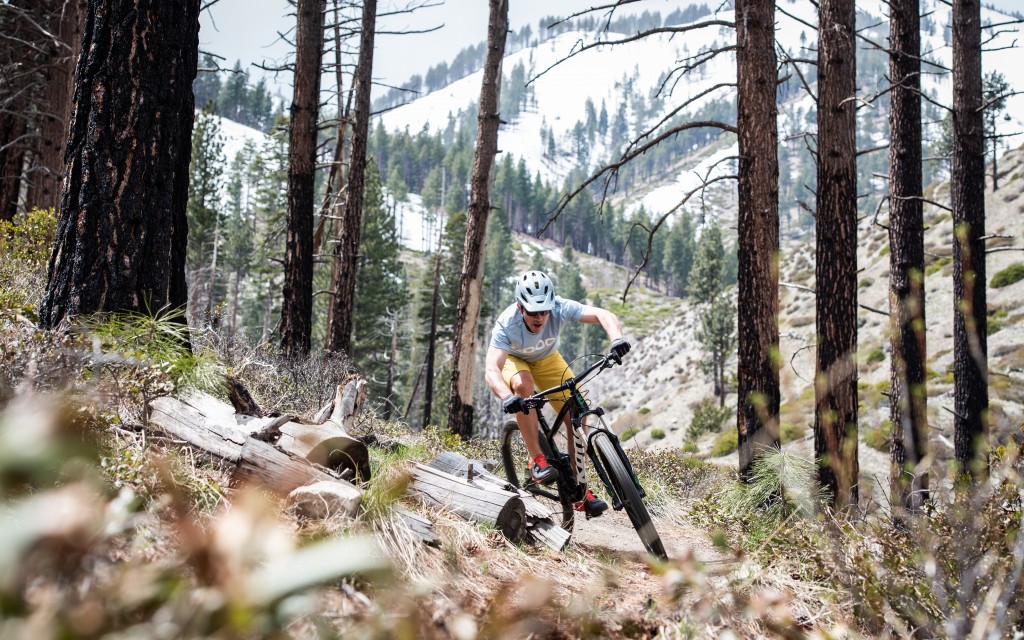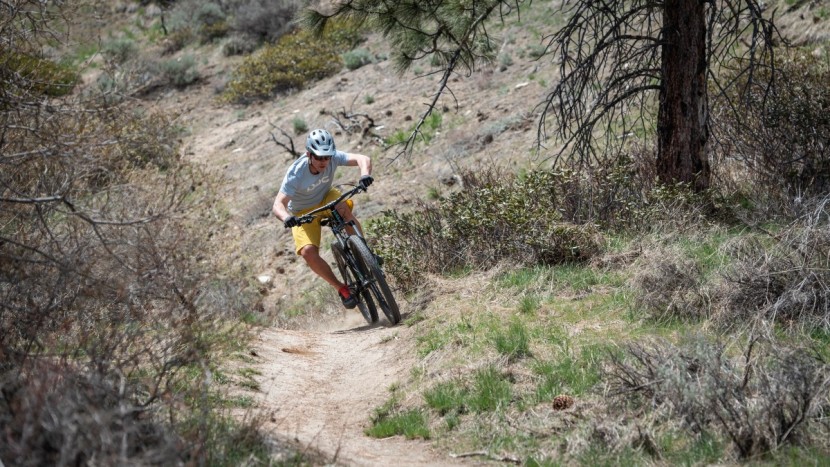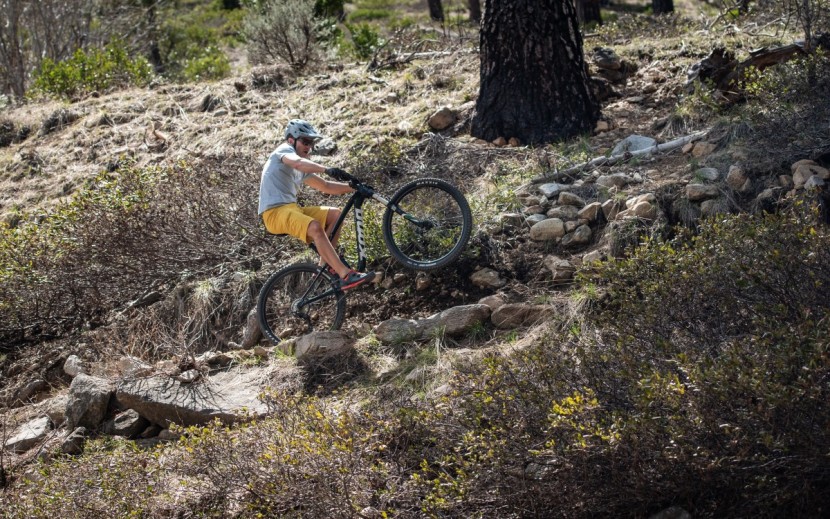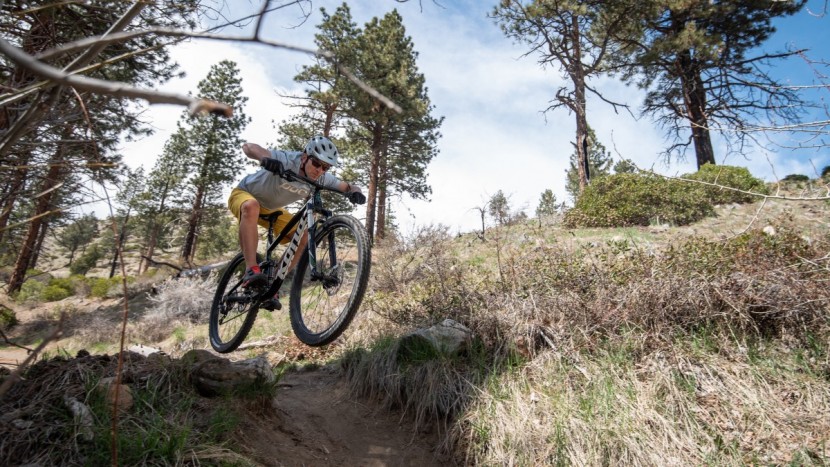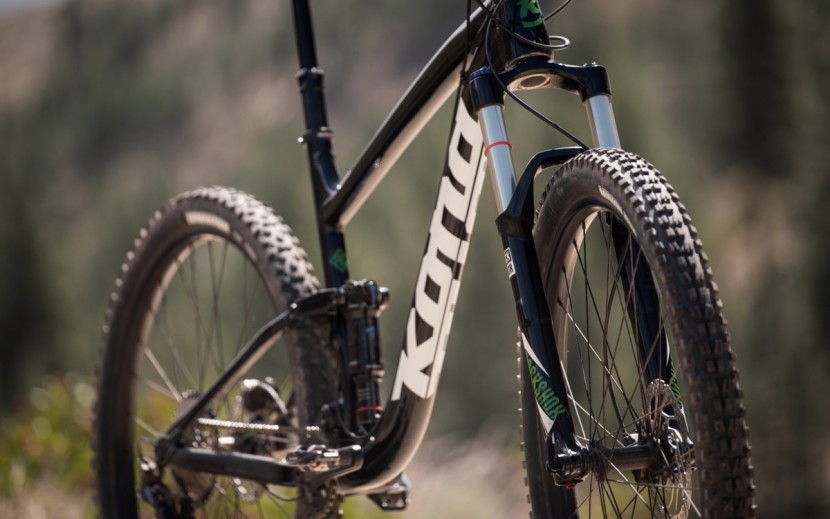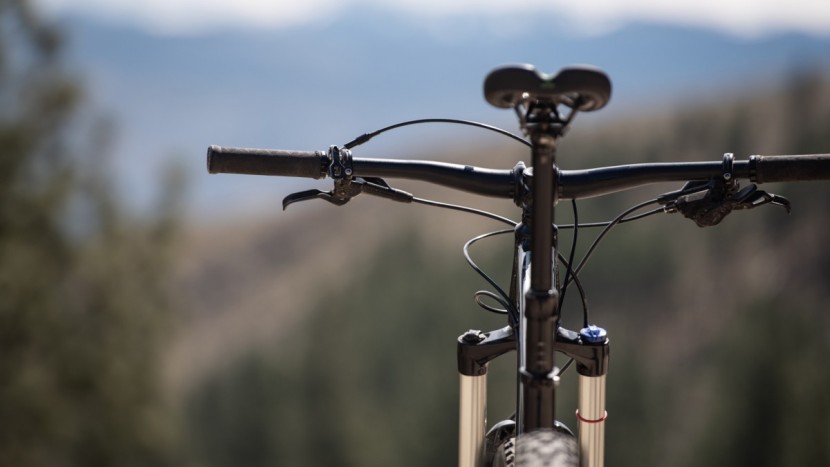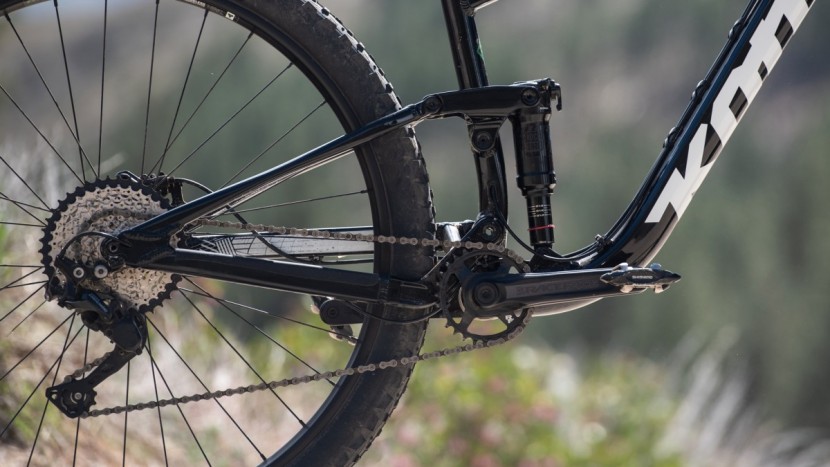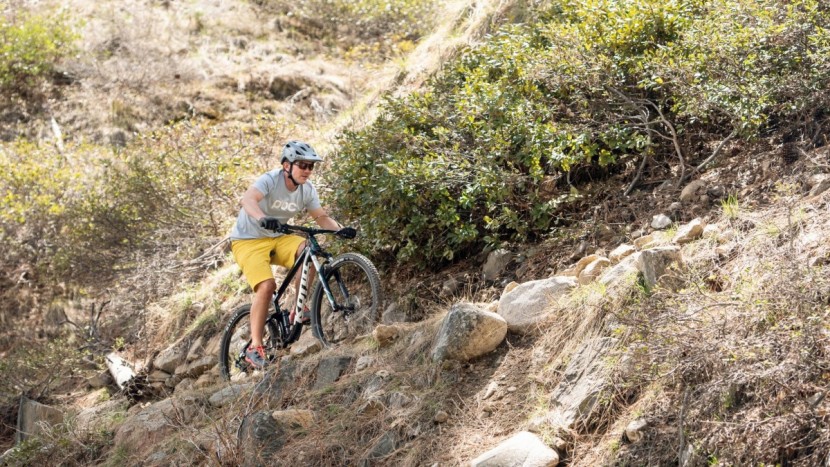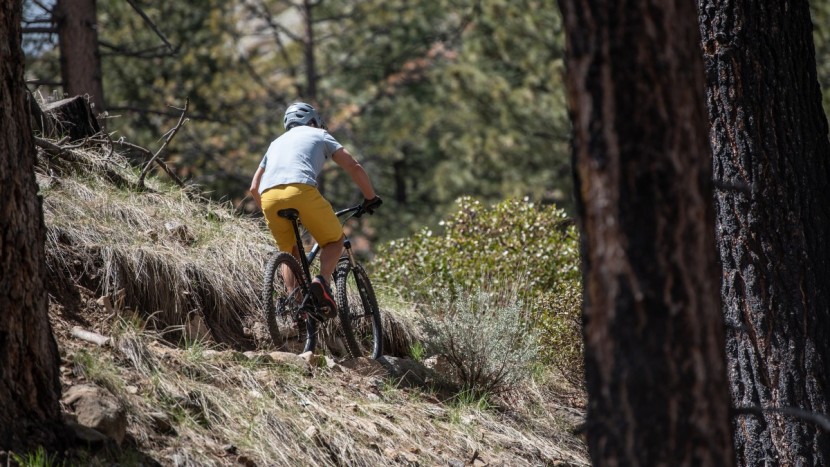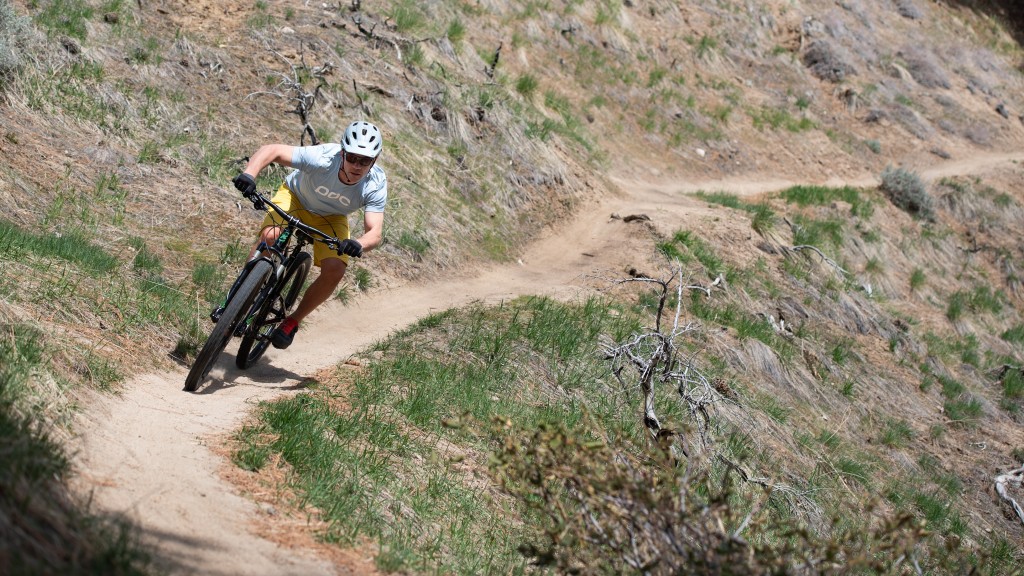Kona Satori Review
Our Verdict
Our Analysis and Test Results
Should I Buy this Bike?
The Satori is an interesting bike that stands apart from the competition due to its relatively unique geometry. When you look at this bike's numbers on paper it seems almost a little confusing with a really steep seat tube, long wheelbase, short chainstays, and relatively steep head tube. It's half progressive modern geometry and half old school, we had a hard time predicting how this bike would ride. When the rubber meets the dirt and you throw a leg over it, however, it makes more sense but it still manages to fall into a category of its own. It performs well on the climbs and crawls over technical sections and around tight uphill switchbacks with ease. It's more mild-mannered on the descents with a smooth and mellow feel that hugs the ground and prefers low to moderate speeds. If a bike that climbs like a goat and is calm and laid back on the descents sounds like your cup of tea, then perhaps the Satori is the bike for you.
While we certainly enjoyed our time testing the Satori, most of our testers preferred the more well-rounded performance of our Editor's Choice, the YT Jeffsy AL Base. Not only is the YT less expensive than the Satori, but it has a significantly more shred ready build and impressed us with its exceptional all-around performance. The Jeffsy is one of a select few bikes in this price range that our testers truly felt comfortable pushing their limits on.
If you like a more playful ride we suggest checking out the Kona Hei Hei Trail. The Hei Hei Trail is similar in many ways to the Satori but sets itself apart with more playful trail manners that will have you constantly searching for side hits and places to manual. The bikes share an almost identical component specification and price, but they have markedly different trail manners.
Fun Factor
It goes without saying that riding bikes is fun, and our testers definitely had a great time while riding the Satori. It has more of a mild-mannered and mellow feel to it and prefers moderate speeds. One of our tested referred to this bike as feeling “planted with a speed limit”. If that sounds like your riding style then this bike is really a blast to ride. If you're looking for something playful or lively or that can charge with confidence at speed, you'll probably want to look elsewhere.
Downhill Performance
The Satori is undoubtedly a fun bike to ride downhill, although it performs best at moderate speeds. It doesn't feel especially lively or poppy like some other competitors, instead it feels more planted but with a speed limit. At higher speeds, the steeper head tube angle becomes more apparent and it can occasionally have a slightly twitchy feel. We experimented with the stack height below the stem and found that stability increased the lower we dropped the stem.
When ridden at its preferred moderate speeds it can handle just about whatever comes down the trail. It's not zippy or super quick, it has a more mellow demeanor that's quite agreeable in most situations. There's nothing especially exciting about it, but it performs well enough. When the going gets steep you can start to feel the steeper head tube angle and the downhill limitations of the Satori's geometry. You can tackle just about any steepness of trail on it, you'll just want to dial back the speed and aggression in the really steep or super rough stuff.
Despite being quite budget, the suspension feels good on the Satori. The fork is supple and the rear suspension is supportive at the beginning of the stroke with a pretty linear feel on larger hits. The wide bars are great for handling and steering input and the dropper seat post is indispensable on the descents. We also love the Maxxis Minion DHF front tire that has an aggressive tread that offers predictable cornering traction.
Uphill Performance
The Satori is particularly adept at climbing thanks primarily to its unique geometry. This bike scrambles up and over technical obstacles with ease and feels comfortable in tight quarters and uphill switchbacks.
At a measured angle of 78.1 degrees, the Satori has the steepest seat tube angle of any bike we've ever tested. This puts the rider right up above the cranks for solid power transfer and a more forward position that enables this bike to claw its way over tricky obstacles in the trail. It has a somewhat long 1205mm wheelbase, but the steep seat tube helps to make the reach of the bike feel shorter than the measured 477mm and it has a relatively upright seated pedaling position. While the wheelbase may be on the long side, the steeper head tube angle and forward rider position still allow for quick handling and a short turning radius for tackling tight uphill switchbacks.
While the Satori felt like a capable climber in most situations the bike had an oddly draggy feeling to it. We could never quite put our finger on it, but it felt like we were expending more energy climbing on this bike compared to other models in the test. This was especially evident when riding bikes back to back and side by side with other testers.
Build
The model we tested is the lower priced of two Satori models in Kona's lineup. It comes with a functional but budget oriented build that is nearly identical to that of the Kona Hei Hei Trail. Like so many bikes in this price range, the component specification isn't fancy but gets the job done. Compared to some of the other models in this review, like the consumer direct YT Jeffsy AL Base, the build on the Satori is less impressive and costs more at retail.
Kona has spec'd a RockShox Recon Gold fork to handle the 140mm of front wheel travel. Recon forks aren't our favorite, but the Gold versions feel significantly better than the Silver versions that come on some bikes in this price range. It feels plush and has a reasonable level of tune-ability, plus it also has boost spacing and a 15mm thru-axle that helps to add a little stiffness to this otherwise somewhat flexy fork. The RockShox Deluxe RL shock controls the Satori's 130mm of rear wheel travel. The rear suspension design works well and the rear end of this bike feels plush enough.
The Satori rolls on a set of WTB STP i29 TCS rims laced to Shimano Deore hubs. The rims are tubeless compatible and have a nice 29mm internal width that pairs well with today's wider profile tires. For rubber, Kona has spec'd a combination of Maxxis tires including a 2.3" Maxxis Minion DHF up front. The DHF is an excellent tire that helps give this bike confidence inspiring traction when cornering in a large variety of conditions. The Maxxis Tomahawk rear tire rolls fast, but the low profile center tread doesn't provide much in the way of climbing or braking traction.
In typical Kona fashion, they've spec'd a nice wide 780mm handlebar with a short stout stem with a 35mm clamp size. This combo is nice and roomy and provides responsive handling with Kona Key Grip lock-on grips. A comfortable WTB Volt Sport SE saddle sits atop a Tranz-X dropper post. We love the inclusion of a dropper post, although we'd prefer an under-mount 1x style remote lever instead of the vertically oriented paddle style lever they included. We've generally had good success with Tranz-X droppers in the past but our test model developed a little stickiness in its travel by the end of our test period.
Kona chose a 10-speed Shimano Deore drivetrain for the Satori. We can't really complain about the reliability or function of Deore components, although we prefer the larger gear ranges offered by 11 and 12-speed setups. A set of Shimano MT500 brakes are employed to slow and stop the Satori and while they aren't anything fancy they do provide adequate braking power. The rear brake developed a terrible squeal over time, likely the result of the pads getting glazed or contaminated.
Best Applications
Testers found the Satori's unique geometry to be well suited to technical climbing and moderate speeds on the descents. The steep seat tube angle and steeper head tube angle help this bike scramble up tight and technical sections of trail with quick and responsive handling. This bike prefers moderate speeds on the descents and has an active, ground-hugging suspension feel. Due to the steeper head tube angle, the Satori is a little less confidence inspiring at high speeds and in steeper sections of trail.
Value
At a retail price of $2,399 we feel the Satori is an okay value. We aren't especially impressed with the build at this price, but it does get the job done and there isn't really anything you have to change to get out and ride. This bike's unique geometry and trail performance is likely to only appeal to a certain subset of riders, so we feel that it may represent a better value depending on your riding style. Overall, we are far more impressed with the value of the Editor's Choice award-winning YT Jeffsy AL Base for its well-rounded performance and more impressive component specification.
Conclusion
The Satori is a mild-mannered mid travel trail bike with a unique geometry. Its performance falls in a category of its own, with impressive climbing abilities and a capable all-around performance that prefers moderate speeds and a mellow rider. It's far from the hardest charging bike in this review, but it can handle just about anything as long as you stay within its speed limits. If you don't push the envelope on descents but you're looking for a versatile ride bike for XC style trail riding the Satori may be a good option for you.
Other Versions
The Satori we tested is the less expensive of 2 models and is available in sizes S-XL.
- The Satori DL, $3,499, shares the same frame and geometry as the model we tested but comes equipped with a RockShox Revelation RC fork, RockShox Deluxe RL DebonAir rear shock, SRAM GX Eagle drivetrain, SRAM Guide R brakes, and a RockShox Reverb dropper seat post.



